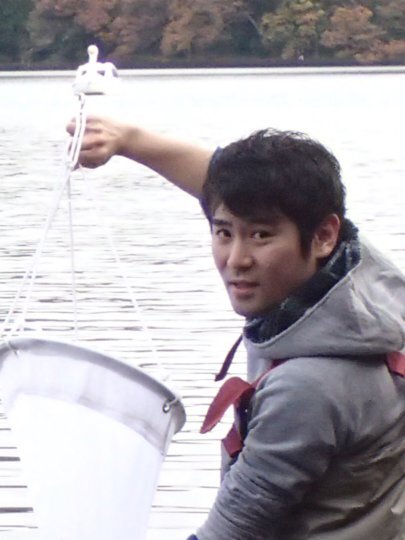Ryo Onuma, Ph.D.
Lecturer, Division of Biodiversity, Evolution and phylogeny
Research Interests
Plastids in algae and plants are organelles derived from the phenomenon of endosymbiosis in which organisms that originally lived by feeding on other organisms (heterotrophs) incorporated photosynthetic organisms into their cells and eventually integrated as a single organism. The acquisition of plastids through this endosymbiosis is thought to have occurred in several eukaryotic lineages, and is a powerful driving force in the evolution of organisms without chloroplasts to become algae. Algae were originated from endosymbiosis in which two organisms integrated to one organism, but many questions remain about the evolutionary process of the endosymbiosis. Our laboratory aims to unravel mechanisms behind the evolution that transformed non-algal organisms into algae by focusing on organisms that exhibit the “kleptoplasty” (stolen plastid), a phenomenon that appears to be intermediate stage in the process of becoming algae.
Research Focus
1. Mechanisms of kleptoplastic phenomenon.
2. Evolution of plastid aquisition in algae using kleptoplastic organisms
as a model.
3. Diversity of endosymbiosis phenomenon in aquatic environment.
Recent Publications
- Onuma R, Hirooka S, Kanesaki Y, Fujiwara T, Yoshikawa H, Miyagishima S (2020).
Changes in the transcriptome, ploidy, and optimal light intensity of a cryptomonad upon integration into a kleptoplastic dinoflagellate.
The ISME Journal 14: 2407–2423.
- Ohbayashi R, Hirooka S, Onuma R, Kanesaki Y, Hirose Y, Kobayashi Y, Fujiwara T, Furusawa T, Miyagishima,
S. (2020).
Evolutionary changes in DnaA-dependent chromosomal replication in cyanobacteria.
Frontiers in microbiology 11: 786.
- Uzuka A*, Kobayashi Y*, Onuma R*, Hirooka S, Kanesaki Y, Yoshikawa H, Fujiwara T, Miyagishima S. (2019)
Responses of unicellular predators to cope with the phototoxicity of photosynthetic prey.
Nature Communications 10: 5606. (*; co-first author)
- Yamada N, Bolton JJ, Trobajo R, Mann DG, Dąbek P, Witkowski A, Onuma R, Horiguchi T, Kroth PG. (2019).
Discovery of a kleptoplastic ‘dinotom’dinoflagellate and the unique nuclear dynamics of converting kleptoplastids to permanent plastids.
Scientific Reports 9: 1-13.
- Yokouchi K, Onuma R, Horiguchi T. (2018).
Ultrastructure and phylogeny of a new species of mixotrophic dinoflagellate, Paragymnodinium stigmaticum sp. nov.(Gymnodiniales, Dinophyceae).
Phycologia 57: 539-554.
- Hirooka S, Hirose Y, Kanesaki Y, Higuchi S, Fujiwara T, Onuma R, Era A, Ohbayashi R, Uzuka A, Nozaki H, Yoshikawa H, Miyagishima S. (2017).
Acidophilic green algal genome provides insights into adaptation to an acidic environment.
Proc. Natl. Acad. Sci. U.S.A., 114: E8304-E8313.
- Onuma R, Neha M, Miyagishima S. (2017)
Regulation of chloroplast and nucleomorph replication by the cell cycle in the cryptophyte Guillardia theta.
Scientific Reports 7: 2345.
- Onuma R, Horiguchi T (2016)
Specificity of Chroomonas (Cryptophyceae) as a sourceof kleptochloroplast for Nusuttodinium aeruginosum (Dinophyceae).
Phycological Research 64: 35-43.
- Onuma R, Watanabe K, Horiguchi T (2015)
Pellucidodinium psammophilum gen. & sp. nov. and Nusuttodinium desymbiontum sp. nov. (Dinophyceae), two novel heterotrophs closely related to kleptochloroplastidic dinoflagellates.
Phycologia 54: 192-209.
- Onuma R, Horiguchi T (2015)
Kleptochloroplast enlargement, karyoklepty and the distribution of the cryptomonad nucleus in Nusuttodinium (= Gymnodinium) aeruginosum (Dinophyceae).
Protist 166: 177-195.
- Gómez F, Onuma R, Artigas LF, Horiguchi T. (2015)
A new definition of Adenoides eludens, an unusual marine sand-dwelling dinoflagellate without cingulum, and Pseudadenoides kofoidii gen. & comb. nov. for the species formerly known as Adenoides eludens.
European Journal of Phycology 50: 125-138.
- Watanabe K, Miyoshi Y, Kubo F, Onuma R, Murray S, Horiguchi T. (2014).
Ankistrodinium armigerum sp. nov.(Dinophyceae), a new species of heterotrophic marine sand‐dwelling dinoflagellate from Japan and Australia.
Phycological research 62: 125-135.
- Onuma R, Horiguchi T. (2013)
Morphological transition in kleptochloroplasts after ingestion in the dinoflagellates Amphidinium poecilochroum and Gymnodinium aeruginosum (Dinophyceae).
Protist 164: 622–642.
- Hagino K, Onuma R, Kawachi M, Horiguchi T. (2013)
Discovery of an endosymbiotic nitrogen-fixing cyanobacterium UCYN-A in Braarudosphaera bigelowii (Prymnesiophyceae).
PloS one 8: e81749.
Contact
Office: Marine site, room 026
Tel: +81-799-72-2907
E-mail: ryoonuma@harbor.kobe-u.ac.jp
 JAPANESE
JAPANESE 